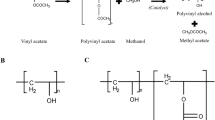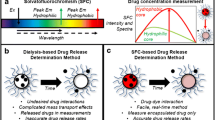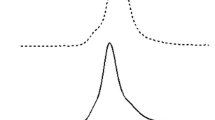Abstract
Purpose
To study the impact of the size and the structure of the nano-assembly on the drug/particle association, determining the intrinsic partition coefficient, in order to better master the encapsulation and release properties of the carrier.
Methods
An experimental methodology is proposed to characterize the drug/nanoparticle association by mean of a partition coefficient between the PLA-PEG nanoparticles and the suspending aqueous medium, referred to as Kp. The determination was made from apparent values (referred to as Kp ap) measured in the presence of solubilizing agents (albumin and hydroxypropyl-βcyclodextrin) and extrapolation to zero concentration. The structure of nanoparticles was investigated by Transmission Electron Microscopy and static light scattering.
Results
Depending on the manufacturing process and the PEG length of the copolymer, the nanoparticles structured either as aggregates of copolymer chains or micelles exhibiting significantly different Kp values.
Conclusion
The methodological tool described here showed that the difference in cabazitaxel/nanoparticle association between aggregates and micelles could be attributed to the difference in PLA-PEG chains packing.







Similar content being viewed by others
Abbreviations
- a:
-
Length of the lactide monomer repeat unit nm
- a2 :
-
Excluded volume of the particle nm3
- C BSA susp :
-
Concentration of albumin in the external phase mol/L
- C drug bound :
-
Concentration of drug bound to the solubilizing agent mg/mL
- C drug diss :
-
Concentration of drug solubilized in water and associated to the solubilizing agent mg/mL
- C drug free :
-
Concentration of free drug in the external phase mg/mL
- C drug tot :
-
Total concentration of drug mg/mL
- C HPβCD susp :
-
Concentration of HPβCD in the external phase mol/L
- CNaDoc :
-
Concentration of sodium deoxycholate mg/mL
- C PLA − PEG susp :
-
Concentration of PLA-PEG in the suspension mg/mL
- C PLA ‐ PEG Acetone :
-
Concentration of PLA-PEG in acetone mg/mL
- C PLA ‐ PEG CH2Cl2 :
-
Concentration of PLA-PEG in methylene chloride mg/mL
- C solub susp :
-
Concentration of solubilizing agent in the suspension mol/L
- D:
-
Coefficient of diffusion of nanoparticle nm2/s
- dH :
-
Hydrodynamic diameternm
- dn/dc:
-
Specific refractive index increment of the PLA-PEG nanoparticles mL/g
- dPLA-PEG :
-
Bulk density of solid PLA-PEG g/cm3
- η:
-
Viscosity of the dispersed medium of nanoparticles Pa.s
- g:
-
Correlation function of diffusion
- Itol :
-
Intensity of light scattered from a toluene solution, used as a reference
- INP :
-
Intensity of light scattered from the dispersion
- K′:
-
Optical constant mol.cm3/g2
- Kd :
-
Dissolution constant mol/L
- Kp :
-
Partition coefficient between nanoparticle and water
- Kp ap :
-
Partition coefficient between nanoparticle and aqueous phase, containing the solubilizing agent
- MA2 :
-
Second Virial coefficient cm3/g
- m drug encaps :
-
Mass of encapsulated cabazitaxel mg
- Mn PLA-PEG :
-
Average molecular weight of PLA-PEG g/mol
- Mw NP :
-
Average molecular weight of nanoparticles g/mol
- NA :
-
Avogadro’s number mol−1
- Nagg :
-
Aggregation number of nanoparticle
- NPEG :
-
Number of monomer units on PEG
- NPLA :
-
Number of monomer units on PLA
- ntol :
-
Refractive index of toluene
- PDI:
-
Polydispersity index
- q:
-
Scattering vector nm−1
- Rcore :
-
Core radius of PLA-PEG micelle nm
- Rg :
-
Radius of gyration of PLA-PEG nanoparticles nm
- RH :
-
Hydrodynamic radius of PLA-PEG nanoparticles nm
- Rtol :
-
Rayleigh ratio of toluene cm−1
- S caba in solub :
-
Maximal solubility of cabazitaxel in solubilizing agent μg/mL
- Vext :
-
Volume of the external phase mL
- Vint :
-
Total volume of nanoparticles mL
- V PLA − PEG :
-
Volume occupied by one PLA-PEG chain inside the nanoparticle nm3/molec
References
Jain RK, Stylianopoulos T. Delivering nanomedicine to solid tumors. Nat Rev Clin Oncol. 2010;7:653–64.
Prabhakar U, Maeda H, Jain RK. Challenges and key considerations of the enhanced permeability and retention effect for nanomedicine drug delivery in oncology. Cancer Res. 2013;73:2412–7.
Yuan F, Dellian M, Fukumura D. Vascular permeability in a human tumor xenograft: molecular size dependence and cutoff size. Cancer Res. 1995;55:3752–6.
Hrkach J, Von Hoff D, Mukkaram Ali M, Andrianova E, Auer J, Campbell T, et al. Preclinical development and clinical translation of a PSMA-targeted docetaxel nanoparticle with a differentiated pharmacological profile. Sci Transl Med. 2012;4:1–12.
Bazile D, Verrecchia T, Bassoulet MT, Marlard M, Spenlehauer G, Veillard M. Ultradispersed polymer with rate and time control. J Pharm Sci Technol Jpn. 1993;53:10–3.
Bazile D, Prud’homme C, Bassoullet MT, Marlard M, Spenlehauer G, Veillard M. Stealth Me.PEG-PLA nanoparticles avoid uptake by the mononuclear phagocytes system. J Pharm Sci. 1995;84:493–8.
Bazile DV, Ropert C, Huve P, Verrecchia T, Mariard M, Frydman A, et al. Body distribution of fully biodegradable [14C]-poly(lactic acid) nanoparticles coated with albumin after parenteral administration to rats. Biomaterials. 1992;13:1093–102.
Yamaoka T, Abataa AS, Ikada Y. Distribution and tissue uptake of Poly(ethy1ene glycol) with different molecular weights after intravenous administration to mice. J Pharm Sci. 1994;83:601–6.
Qian H, Wohl AR, Crow JT, Macosko CW, Hoye TR. A strategy for control of “random” copolymerization of lactide and glycolide: application to synthesis of PEG-b-PLGA block polymers having narrow dispersity. Macromolecules. 2011;44:7132–40.
Plard JP, Bazile D. Comparison of the safety profiles of PLA50 and Me.PEG-PLA50 nanoparticles after single dose intravenous administration to rat. Colloids Surf B: Biointerfaces. 1999;16:173–83.
Riley T, Stolnik S, Heald CR, Xiong CD, Garnett MC, Illum L, et al. Physicochemical evaluation of nanoparticles assembled from Poly(lactic acid)-Poly(ethylene glycol) (PLA-PEG) block copolymers as drug delivery vehicles. Langmuir. 2001;17:3168–74.
Torchilin V. Tumor delivery of macromolecular drugs based on the EPR effect. Adv Drug Deliv Rev. 2011;63:131–5.
Acharya S, Sahoo SK. PLGA nanoparticles containing various anticancer agents and tumour delivery by EPR effect. Adv Drug Deliv Rev. 2011;63:170–83.
Reddy LH, Bazile D. Drug delivery design for intravenous route with integrated physicochemistry, pharmacokinetics and pharmacodynamics: illustration with the case of taxane therapeutics. Adv Drug Deliv Rev. 2014;71:34–57.
Stern ST, Hall JB, Yu LL, Wood LJ, Paciotti GF, Tamarkin L, et al. Translational considerations for cancer nanomedicine. J Control Release. 2010;146:164–74.
Tyner K, Sadrieh N. Characterization of Nanoparticles Intended for Drug Delivery: S.E. McNeil; 2011.
Delie F, Pascale Ribaux P, Petignat P, Cohen M. Anti-KDEL-coated nanoparticles: a promising tumor targeting approach for ovarian cancer ? Biochimie. 2012;94:2391–7.
Hu Q, Gu G, Liu Z, Jiang M, Kang T, Miao D, et al. F3 peptide-functionalized PEG-PLA nanoparticles co-administrated with tLyp-1 peptide for anti-glioma drug delivery. Biomaterials. 2013;34:1135–45.
Verrecchia T. Mécanisme de libération in vitro d’une molécule hydrophobe encapsulée dans des nanoparticules d’un co-polymère de poly(acide lactique) et de poly(éthylèneglycol) PLA-PEG; 1998.
Landry FB, Bazile DV, Spenlehauer G, Veillard M, Kreuter J. Release of the fluorescent marker Prodan from poly(D, L-lactic acid) nanoparticles coated with albumin or polyvinyl alcohol in model digestive fluids (USP XXII). J Control Release. 1997;44:227–36.
Illum L, Khan MA, Mak E, Davis SS. Evaluation of carrier capacity and release characteristics for poly(butyl2-cyanoacrylate) nanoparticles. Int J Pharm. 1986;30:17–28.
Matsuoka K, Moroi Y. Micelle formation of sodium deoxycholate and sodium ursodeoxycholate (Part 1). Biochim Biophys Acta. 2002;1580:189–99.
Mark JE. Polymer data handbook: Oxford university press; 1999.
Vitale SA, Katz JL. Liquid droplet dispersions formed by homogeneous liquid-liquid nucleation: “The Ouzo Effect”. Langmuir. 2003;19:4105–10.
Botet R. The “ouzo effect”, recent developments and application to therapeutic drug carrying. Journal of Physics: Conference Series. 2012; 352.
Lepeltier E, Bourgaux C, Couvreur P. Nanoprecipitation and the “Ouzo effect”: application to drug delivery devices. Adv Drug Deliv Rev. 2014;71:86–97.
Johnson BK, Prud’homme RK. Mechanism for rapid self-assembly of block copolymer nanoparticles. Phys Rev Lett. 2003;91:118302.
Legrand P, Lesieur S, Bochot A, Gref R, Raatjes W, Barratt G, et al. Influence of polymer behaviour in organic solution on the production of polylactide nanoparticles by nanoprecipitation. Int J Pharm. 2007;344:33–43.
Gao Z, Varshney SE, Wong S, Eisenberg A. Block Copolymer “Crew-Cut” Micelles in water. Macromolecules. 1994;27:7923–7.
Louguet S, Kumar AC, Guidolin N, Sigaud G, Duguet E, Lecommandoux S, et al. Control of the PEO chain conformation on nanoparticles by adsorption of PEO-block-Poly(L-lysine) copolymers and its significance on colloidal stability and protein repellency. Langmuir. 2011;27:12891–901.
De Gennes PG. Conformations of polymers atteached to an interface. Macromolecules. 1980;13:1069–75.
De Gennes PG. Polymers at an interface-a simplified view. Adv Colloid Interf Sci. 1987;27:189–209.
Karnik R, Gu F, Basto P, Cannizzaro C, Dean L, Kyei-Manu W, et al. Microfluidic platform for controlled synthesis of polymeric nanoparticles. Nanoletters. 2008;8:2906–12.
Desgouilles S, Vauthier C, Bazile DV, Vacus J, Grossiord JL, Veillard M, et al. The design of nanoparticles obtained by solvent evaporation: a comprehensive study. Langmuir. 2003;19:9504–10.
Rübe A, Hause G, Mäder K, Kohlbrecher J. Core-shell structure of Miglyol/poly(d, l-lactide)/Poloxamer nanocapsules studied by small-angle neutron scattering. J Control Release. 2005;107:244–52.
Anderson KS, Hillmyer MA. Melt chain dimensions of polylactide. Macromolecules. 2004;37:1857–62.
Julienne MC, Alonso MJ, Gomez Amoza JL JPB. Preparation of Poly(D,L-Lactide/Glycolide) nanoparticles of controlled particle size distribution: application of experimental designs. Drug Dev Ind Pharm. 1992;18:1063–77.
Stepanyan R, Lebouille JGJL, Slot JJM, Tuinier R, Cohen Stuart MA. Controlled nanoparticle formation by diffusion limited coalescence. Phys Rev Lett. 2012;109:138301.
ACKNOWLEDGMENTS AND DISCLOSURES
The post-doctorate fellowship of Odile Diou was financed by Sanofi. The authors would like to thank Guillaume Louit (Sanofi, Vitry sur Seine) for fruitful advices about partition experiments, Jean Alie (Sanofi, Montpellier) for TEM observations and Eric Didier (Sanofi, Vitry sur Seine) for synthesizing PLA-PEG copolymers. The authors acknowledge Thierry Verrecchia who did pioneering experiments on partition coefficient during his Pharm D thesis in 1998.
Author information
Authors and Affiliations
Corresponding author
Rights and permissions
About this article
Cite this article
Diou, O., Greco, S., Beltran, T. et al. A method to Quantify the Affinity of Cabazitaxel for PLA-PEG Nanoparticles and Investigate the Influence of the Nano-Assembly Structure on the Drug/Particle Association. Pharm Res 32, 3188–3200 (2015). https://doi.org/10.1007/s11095-015-1696-0
Received:
Accepted:
Published:
Issue Date:
DOI: https://doi.org/10.1007/s11095-015-1696-0




